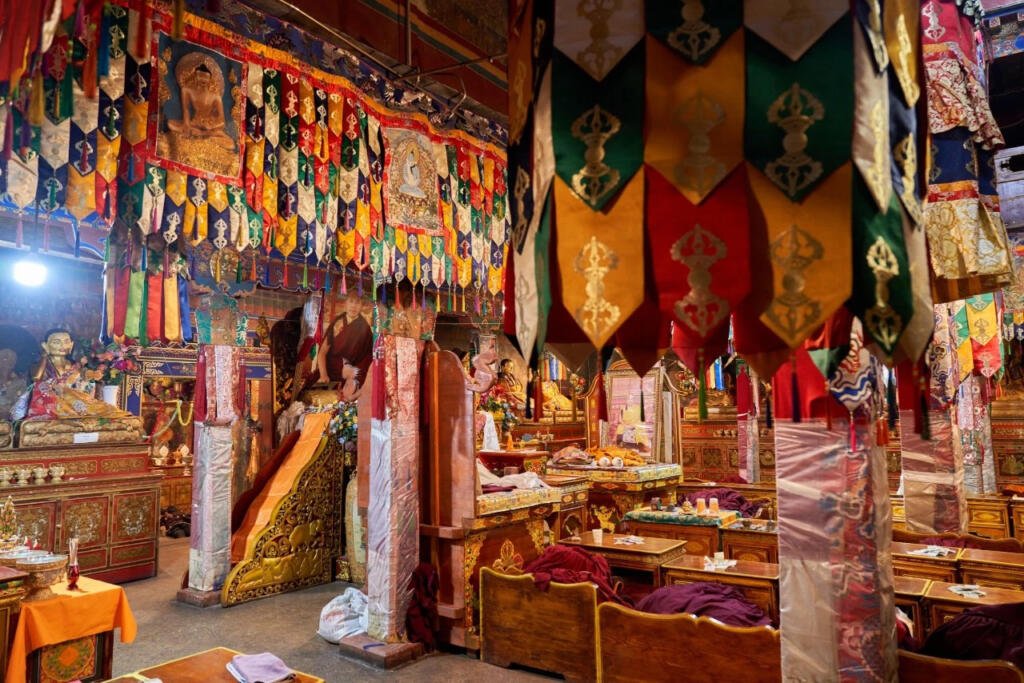Nedong Tse Tsokpa Monastery སྣེ་གདོང་རྩེ་ཚོགས་པ།, gracefully poised on the slopes that mimic a slumbering elephant beside Gongpo Ri Mountain in Nedong County, is a bastion of Tibetan Buddhism’s storied past. As the chronicles of the temple recount, the Phakdru Kagyu authority, led by Situ Jangchup, dismantled the regional Sakya rule to establish their governance in Nedong, culminating in the construction of Tse Tsokpa Temple in 1356.
The Grandeur of the Main Temple
- Three-Story Marvel: The principal hall of the temple rises three stories high, a majestic beacon of spiritual devotion.
- Ascending the Sacred Steps: A series of stone steps leads to the temple’s grand entrance, flanked by a gallery with nine chambers – a threshold to sanctity.
- Guardians at the Gate: The doorway is guarded by murals of the Four Heavenly Kings from 17 century.
- A Sanctuary of Scriptures: Within the hall’s 54 rooms, supported by 40 pillars, lies a repository of 1090 Buddhist texts, a treasure trove of ancient wisdom.

The Sanctum’s Inner Peace
- Divine Residents: The back hall hosts a Sakyamuni Buddha statue, with Tara and the Fifth Dalai Lama standing guard; a Buddhist cabinet filled with exquisite small gold and bronze Buddha statues marks the center.
- The Essence of Enlightenment: This sacred space, encompassing six chambers, holds statues of the Third Buddha and eight great Bodhisattvas, embodying simplicity and grandeur.
- Protectors of the Faith: Statues of guardian deities adorn the south wall, while the revered Tsongkhapa, flanked by Gyaltsab Jey and Kheddrup Jey , with Atisha on one side and Pamaasambhava on the other, bless the left hall.
A Canvas of Devotion
- Murals of the Enlightened: The temple walls bear the images of the Third Buddha, Dorje Semba, Dorje Phurpa, and the Great White Umbrella Canopy Buddha Mother.
- Gonkang: The Protector’s Realm: In the right hall, beautifully crafted statues of protector gods stand in eternal vigilance.
Highlights of Tse Tsokpa Temple
Sakyamuni Buddha Silk Thangka:
Revered as the temple’s most precious artifact, this silk thangka is believed to have been personally embroidered by Princess Wencheng. It stands at a striking height of 2.92 meters and a width of 1.72 meters, featuring a blue background with golden edges. The central figure of Sakyamuni is rendered in golden skin with a blue topknot and draped in a red robe adorned with the eight precious symbols.
he robe reveals the right shoulder, and the hands are positioned in the earth-touching and meditative mudras. Sitting in a lotus position, the Buddha is surrounded by a colorful halo decorated with lotus flowers, with a sun, a three-legged golden bird, and a moon with the image of a rabbit pounding herbs depicted above. The thangka’s weaving is exquisite and tightly structured, making it a masterpiece among silk images.
Eleven-faced Guanyin Bronze Statue:
While most of the common depictions of the eleven-faced Guanyin in Tibet are standing figures, the Tse Tsokpa Temple houses an exceptionally rare seated version of the statue. It measures 35 centimeters in height, 18 centimeters in width, and 9 centimeters in depth. The statue features a straight, high nose and protruding lower lip, with large earrings adorning the ears and bracelets on the arms. The upper body is bare, and the lower body is clothed in a skirt.
Although the head part is damaged, with ten faces remaining, they are arranged in tiers, three to a level, with the topmost level having one face, all representing transformed Buddhas. The deity has eight arms, two joined in prayer at the chest, two hanging down to the knees, the left hand holding a vase, and the other four arms gracefully holding items like a lotus and prayer beads. The figure is seated in a cross-legged position on a triangular cushion, showcasing a distinct Indian style.
Phola Nai Seal Decree:
Written on a yellow silk scroll measuring 3.8 meters in length and 0.74 meters in width, the topmost column features Sanskrit in bold script (undeciphered). Issued by Phola Nai (1689–1747) in the year of the Earth Snake (1730) on the 30th day of the tenth month according to the Tibetan calendar, the document has a history of over 280 years.
The text, handwritten in Tibetan, outlines the temple’s jurisdiction, monk personnel, number of slaves, and the extent of the estate (gzhis-ka, meaning manor). The decree is signed by the Ganden Podrang and is authenticated by one small seal at the top and two larger seals at the bottom, all bearing Mongolian script.
